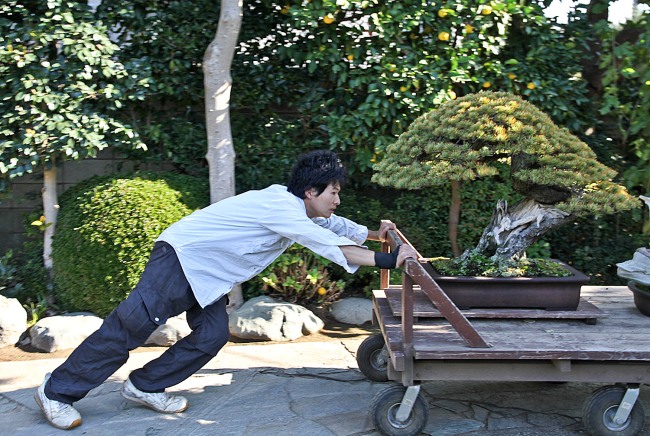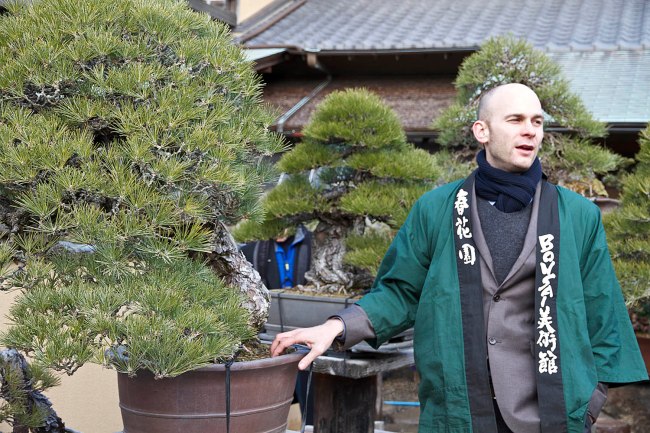Bonsai Society Of Western Australia
Two years ago I was invited to The Bonsai Society of Western Australia on my return trip home from the South African Bonsai Convention where I was teaching. The club had some excellent trees in Perth and the people were friendly. The dynamic, energetic and well organized Dianne Boekhout is president and did an excellent job planning my teaching tour this year, just as she did two years ago where I went completely around the world in 21 days.
The Bonsai Society of Western Australia again invited me back and I’ve just finished presenting six programs: two critiques, two lecture demos and two workshops. Additionally another program was presented for another local club The Bonsai Workshop. That’s quite a lot of information to absorb in a couple of days and tiring for me as well. Well, this group is up to it and are serious about learning bonsai. Their bonsai and understanding is increasing and it was a pleasure to see the same working core of people still involved promoting bonsai and making information available to new comers to our art.
The first critique had some interesting bonsai, mostly foreign to me because they primarily are using native Australian plant material. As I’ve mentioned before, this area of the world reminds me of Florida with mountains. The plants are similar, but of tremendous diversity. We went to a nursery and I hardy recognized any plants. At the critique all the plants were well shaped and well shaped. A few of them were displayed on proper stands. I briefly spoke about display tables and how some kind of table or even a covered box raises the bonsai off the table to elevate the tree and shows respect for greater appreciation. That’s all I said. Two days later at my literati bonsai seminar nearly ALL the bonsai were displayed on stands and a few even had companion plantings. These people are serious about learning, improving and listened to what I trying to share with them.
The next day after the critique we had my Cascade Bonsai Seminar beginning with a lecture/demonstration and continuing in the afternoon with a workshop. Two years ago, during my last teaching trip here, I presented a unique demonstration taking a 45 inch tree and removing 17 inches from the bottom creating a 28 inch tall tree. Only the top section and root system was kept, 17” of the straight trunk was eliminated. The new shortened tree had power. Well, this year they had some interesting material and I again did something different, well for me at least.
My demo tree, a large Dwarf Japanese garden juniper, was being trained in the root-over-rock style in a clay training pot. The pot was heavy and I was not allowed to move it, but was able to turn the tree while working on it. The trunk had potential for a good cascade style bonsai, but I was not particularly interested in the rock. In fact, I had planned on removing the tree from the rock. Upon closer study, the combination was quite good and we decided to create a root-over-rock cascade style bonsai. The “right” container was not available, but Dianne, my host for my visit, went home and returned with a couple of suitable pots. She assisted me in the wiring and potting and the tree came out better than anticipated. A workshop on cascade style bonsai followed where nearly everyone created this style.
The next day we had the identical schedule, but only with my Literati Style Bonsai Seminar. As mentioned there were an abundant number of excellent literati style bonsai, all on display tables and we used many of them to illustrate design elements and offered suggestions for refinement.
The demonstration tree was again not the normal 5 gallon size juniper which is common in many areas. Diane had a well trained informal upright style Dwarf Japanese garden juniper which was developed and looked good, just as it is. Since she has other similarly styled bonsai this specimen was not special and was boring in her collection. So I removed most of the branches with her approval that of the members. Remember I mentioned the members have an excellent understanding of bonsai. The result was a literati style bonsai.
Original front before redesign
Original back before redesign
Removing front branch
Another branch gone
One more to go
Container selection- too large, but right shape, color and quality
The smaller container, right size and shape
Two containers were available for the tree, one was the perfect design, color and quality, but slightly too large. The other container was about the right size, but everyone, including me liked the color and shape of the larger pot. So, we had a discussion on container selection and what is the most important element for deciding which pot to use: color, size, design or quality. That’s not an easy answer especially
for good trees and with a learned audience there were many valid opinions. I potted the tree in the smaller container but wish I had a “pot shrinker” for the larger one. We continued on with showing proper transplanting techniques for the beginners in the group. All my programs in Perth were free, including the workshops, and open to the public. The club is trying to expand the art in the state as well as get new members.
Completed demo tree redesigned
Again after lunch we had a workshop where everyone created a literati style or forest bonsai. Most of the students were the same serious members from yesterday, I guess they were not tired of me yet.
Filippe worked on a forest with Japanese boxwood cuttings he rooted and grew
Nick created a literati style Dwarf Japanese garden juniper
Since my next program was in the evening, Dianne took me on a whale watch trip on a boat in the Indian Ocean. It was quite fun and I enjoyed seeing these huge mammals migrate from the north to Antarctica in the south for the hot summer months. The whales are beautiful and large too, the tongue weighs two tons and their heart weighs another ton. Since they were moving rapidly the whales did not do any tricks, but I was able to get a few photos of them diving into the deep, blue water below. I had a “whale” of a good time…
In the evening we had a special critique where members brought in the tray landscapes they created in my workshop two years ago. Just by chance I had photographed them two years ago after the workshop and they were among the 40,000 images on my Mac laptop. After searching and formatting them a new Powerpoint presentation was created and shown with the critique. I was amazed at how well the members trained and refined their tray landscapes. Looking back at the original images some were just stick forests, but developed into pleasing tray landscapes.
2011
2013
2011
2013
The following evening I presented my Aspects of Bonsai Design program which included a critique for The Bonsai Workshop group. Many interesting bonsai, mostly of native Australian plants, were discussed.
During the past 12 days I have presented 16 educational programs for five bonsai societies and a study group. As my teaching tour throughout Australia concludes I’d like to thank the society members who participated in my educational events, my friendly hosts who made me feel welcome and especially Dianne who spent considerable time to organize the event. Additionally, my wife Diane and Senior Crew who cared for my bonsai during the trip need to be thanked, because without them, the trip would not be possible.
But, I’m not home yet, the Golden State Bonsai Convention in California is my next stop.



















































































































































































































































































































































































































































































































